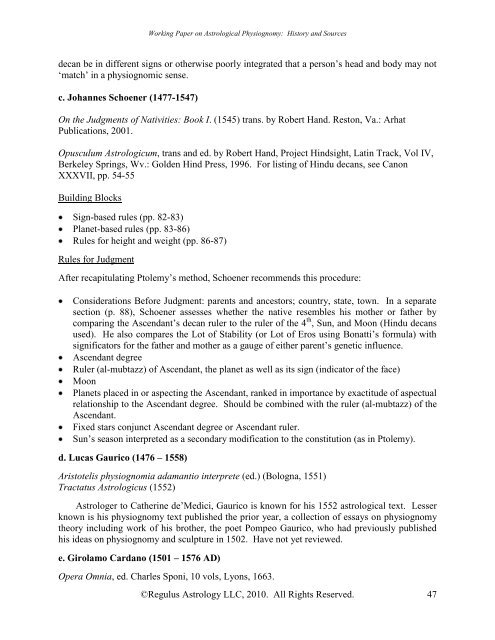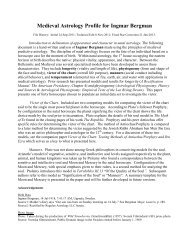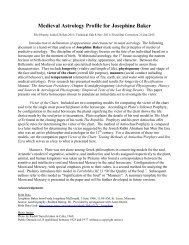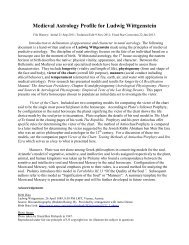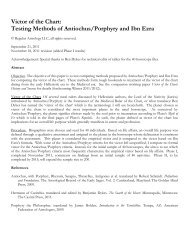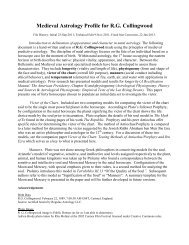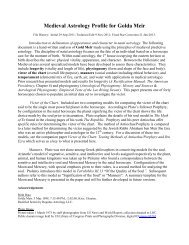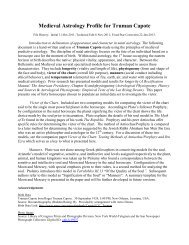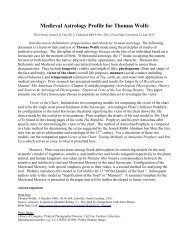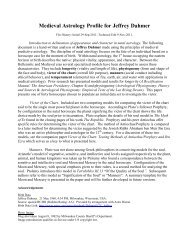Working Paper on Astrological Physiognomy: History and Sources
Working Paper on Astrological Physiognomy: History and Sources
Working Paper on Astrological Physiognomy: History and Sources
Create successful ePaper yourself
Turn your PDF publications into a flip-book with our unique Google optimized e-Paper software.
<str<strong>on</strong>g>Working</str<strong>on</strong>g> <str<strong>on</strong>g>Paper</str<strong>on</strong>g> <strong>on</strong> <strong>Astrological</strong> <strong>Physiognomy</strong>: <strong>History</strong> <strong>and</strong> <strong>Sources</strong><br />
decan be in different signs or otherwise poorly integrated that a pers<strong>on</strong>’s head <strong>and</strong> body may not<br />
‘match’ in a physiognomic sense.<br />
c. Johannes Schoener (1477-1547)<br />
On the Judgments of Nativities: Book I. (1545) trans. by Robert H<strong>and</strong>. Rest<strong>on</strong>, Va.: Arhat<br />
Publicati<strong>on</strong>s, 2001.<br />
Opusculum Astrologicum, trans <strong>and</strong> ed. by Robert H<strong>and</strong>, Project Hindsight, Latin Track, Vol IV,<br />
Berkeley Springs, Wv.: Golden Hind Press, 1996. For listing of Hindu decans, see Can<strong>on</strong><br />
XXXVII, pp. 54-55<br />
Building Blocks<br />
Sign-based rules (pp. 82-83)<br />
Planet-based rules (pp. 83-86)<br />
Rules for height <strong>and</strong> weight (pp. 86-87)<br />
Rules for Judgment<br />
After recapitulating Ptolemy’s method, Schoener recommends this procedure:<br />
C<strong>on</strong>siderati<strong>on</strong>s Before Judgment: parents <strong>and</strong> ancestors; country, state, town. In a separate<br />
secti<strong>on</strong> (p. 88), Schoener assesses whether the native resembles his mother or father by<br />
comparing the Ascendant’s decan ruler to the ruler of the 4 th , Sun, <strong>and</strong> Mo<strong>on</strong> (Hindu decans<br />
used). He also compares the Lot of Stability (or Lot of Eros using B<strong>on</strong>atti’s formula) with<br />
significators for the father <strong>and</strong> mother as a gauge of either parent’s genetic influence.<br />
Ascendant degree<br />
Ruler (al-mubtazz) of Ascendant, the planet as well as its sign (indicator of the face)<br />
Mo<strong>on</strong><br />
Planets placed in or aspecting the Ascendant, ranked in importance by exactitude of aspectual<br />
relati<strong>on</strong>ship to the Ascendant degree. Should be combined with the ruler (al-mubtazz) of the<br />
Ascendant.<br />
Fixed stars c<strong>on</strong>junct Ascendant degree or Ascendant ruler.<br />
Sun’s seas<strong>on</strong> interpreted as a sec<strong>on</strong>dary modificati<strong>on</strong> to the c<strong>on</strong>stituti<strong>on</strong> (as in Ptolemy).<br />
d. Lucas Gaurico (1476 – 1558)<br />
Aristotelis physiognomia adamantio interprete (ed.) (Bologna, 1551)<br />
Tractatus Astrologicus (1552)<br />
Astrologer to Catherine de’Medici, Gaurico is known for his 1552 astrological text. Lesser<br />
known is his physiognomy text published the prior year, a collecti<strong>on</strong> of essays <strong>on</strong> physiognomy<br />
theory including work of his brother, the poet Pompeo Gaurico, who had previously published<br />
his ideas <strong>on</strong> physiognomy <strong>and</strong> sculpture in 1502. Have not yet reviewed.<br />
e. Girolamo Cardano (1501 – 1576 AD)<br />
Opera Omnia, ed. Charles Sp<strong>on</strong>i, 10 vols, Ly<strong>on</strong>s, 1663.<br />
©Regulus Astrology LLC, 2010. All Rights Reserved.<br />
47


